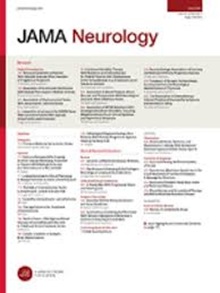Behavioral Compared With Drug Therapy for Overactive Bladder Symptoms in Parkinson Disease: A Randomized Noninferiority Trial.
IF 21.3
1区 医学
Q1 CLINICAL NEUROLOGY
引用次数: 0
Abstract
Importance Overactive bladder (OAB) symptoms in Parkinson disease (PD) are burdensome, and the adverse effects of drug treatment can worsen PD-associated morbidity. Drug adverse effects are avoided with pelvic floor muscle exercise-based behavioral therapy. Objective To assess the noninferiority of behavioral compared with solifenacin drug therapy for OAB symptoms in persons with PD. Design, Setting, and Participants This 12-week randomized noninferiority trial of behavioral therapy compared with solifenacin was conducted between 2018 and 2023 within 4 US Veterans Affairs health care systems. Eligible participants were diagnosed with PD by a movement disorder neurologist and had an International Consultation on Incontinence Questionnaire OAB module (ICIQ-OAB) symptom score of 7 or higher (range, 0-16; higher score indicates worse symptoms) and Montreal Cognitive Assessment (MOCA) score of 18 or higher (range, 0-30). Participants were randomized 1:1 after stratification by sex, recruitment site, OAB severity, and PD motor symptom severity. Analyses were conducted from October 2023 to April 2024. Interventions Behavioral therapy was implemented by a nurse practitioner and included pelvic floor muscle training and urge suppression strategies. Solifenacin therapy started at 5 mg daily, with titration to 10 mg daily if needed. Main Outcome and Measures The primary outcome was the 12-week ICIQ-OAB score across groups within a 15% noninferiority margin. Adverse events were assessed every 2 weeks for 8 weeks and again at 12 weeks. Results A total of 77 persons with PD (65 [84%] male; mean [SD] age, 71.3 [8.9] years; mean [SD] years with PD, 6.6 [5.8]) were randomized to behavioral (n = 36) or drug therapy (n = 41). Seventy-three participants completed the study (4 dropped out in drug group). Baseline characteristics were balanced across groups, including MOCA score (mean [SD], drug, 23.9 [3.1]; behavioral, 24.8 [3.3]) and ICIQ-OAB score (mean [SD], drug, 9.1 [1.7]; behavioral, 8.5 [1.4]). At 12 weeks postrandomization, ICIQ-OAB scores across groups indicated clinically significant improvement and were within the a priori noninferiority margin of 15% (mean [SD] score, drug, 5.8 [2.4]; behavioral, 5.5 [2.0]; P = .02). Dry mouth and falls were reported more frequently in the drug compared with the behavioral group. Conclusions and Relevance Results of this randomized noninferiority trial suggest that behavioral therapy is noninferior to drug therapy in improving OAB symptoms in PD. These findings may inform clinical guidelines for urinary symptoms in PD to consider behavioral therapy as an initial treatment option. Trial Registration ClinicalTrials.gov Identifier: NCT03149809.帕金森病患者膀胱过度活动症状的行为治疗与药物治疗的比较:一项随机非劣效性试验。
帕金森氏病(PD)的膀胱过动症(OAB)症状是沉重的负担,药物治疗的不良反应可加重PD相关的发病率。以盆底肌运动为基础的行为疗法可避免药物不良反应。目的评价行为疗法与索利那新药物治疗PD患者OAB症状的非劣效性。设计、环境和参与者这项为期12周的随机非劣效性试验是在2018年至2023年期间在4个美国退伍军人事务卫生保健系统中进行的,将行为治疗与索利那新进行比较。符合条件的参与者由运动障碍神经科医生诊断为PD,并有国际失禁咨询问卷OAB模块(ICIQ-OAB)症状评分为7或更高(范围0-16;得分越高表明症状越严重),蒙特利尔认知评估(MOCA)得分为18或更高(范围0-30)。参与者按性别、招募地点、OAB严重程度和PD运动症状严重程度按1:1随机分组。分析时间为2023年10月至2024年4月。干预行为治疗由执业护士实施,包括盆底肌肉训练和冲动抑制策略。索利那新治疗起始剂量为每日5mg,如有需要可滴定至每日10mg。主要结局和测量主要结局是12周ICIQ-OAB评分在15%的非劣效性范围内。不良事件每2周评估一次,持续8周,12周再次评估一次。结果共77例PD患者,其中男性65例(84%);平均[SD]年龄71.3[8.9]岁;PD的平均[SD]年,6.6[5.8])随机分为行为治疗组(n = 36)和药物治疗组(n = 41)。73名参与者完成了研究(药物组4名退出)。各组基线特征平衡,包括MOCA评分(mean [SD],药物23.9 [3.1];行为,24.8[3.3])和ICIQ-OAB评分(平均[SD],药物,9.1 [1.7];Behavioral, 8.5[1.4])。随机化后12周,各组ICIQ-OAB评分均有临床显著改善,且在15%的先验非劣效性范围内(平均[SD]评分,药物,5.8 [2.4];行为学,5.5 [2.0];p = .02)。据报道,与行为组相比,服药组的口干和跌倒发生率更高。结论和相关性:这项随机非劣效性试验的结果表明,行为治疗在改善帕金森病OAB症状方面优于药物治疗。这些发现可能会提示PD患者泌尿系统症状的临床指南,将行为治疗作为初始治疗选择。临床试验注册号:NCT03149809。
本文章由计算机程序翻译,如有差异,请以英文原文为准。
求助全文
约1分钟内获得全文
求助全文
来源期刊

JAMA neurology
CLINICAL NEUROLOGY-
CiteScore
41.90
自引率
1.70%
发文量
250
期刊介绍:
JAMA Neurology is an international peer-reviewed journal for physicians caring for people with neurologic disorders and those interested in the structure and function of the normal and diseased nervous system. The Archives of Neurology & Psychiatry began publication in 1919 and, in 1959, became 2 separate journals: Archives of Neurology and Archives of General Psychiatry. In 2013, their names changed to JAMA Neurology and JAMA Psychiatry, respectively. JAMA Neurology is a member of the JAMA Network, a consortium of peer-reviewed, general medical and specialty publications.
 求助内容:
求助内容: 应助结果提醒方式:
应助结果提醒方式:


